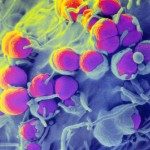Link to Pubmed [PMID] – 22573714
Cancer Res. 2012 Jul;72(14):3557-69
The accumulation of CD4(+) T regulatory cells (Treg) in tumor tissue is a widely described phenomenon in mouse models and in human cancer patients. Understanding the mechanisms by which Treg migrate and accumulate in tumors is important because they strongly influence the potential efficacy of many immunotherapies. In this study, we used immunoscope technology to analyze the T-cell receptor (TCR) repertoire of tumor-infiltrating T cells in non-TCR transgenic mice. Both tumor-infiltrating Tregs and T effector cells (Teff) displayed sequence profiles in the CDR3 region that were characteristic of biased repertoires seen during clonal cell expansions, implying that strong T-cell responses have occurred within the tumor tissue. By comparing the TCR sequences of tumor-infiltrating Tregs, we obtained evidence of the presence of so-called public TCR sequences that are common to many individuals yet were tumor-specific in nature. Such comparisons also suggested that the Treg-Teff conversion process is not an active process at the tumor site or tumor-draining lymph nodes. Our findings strongly suggest that Treg infiltration of tumor tissue is followed by marked proliferation of a few dominant T-cell clones in the tumor.

